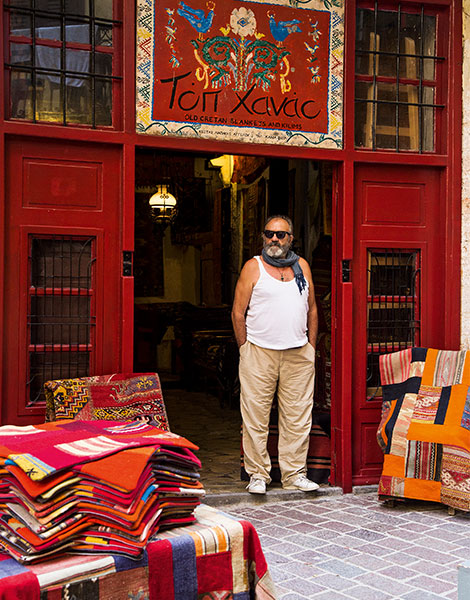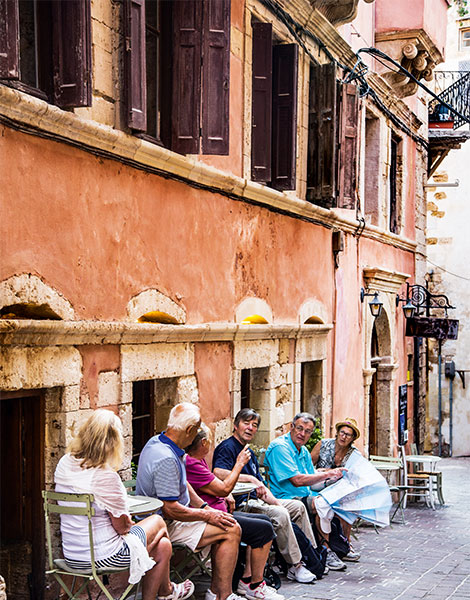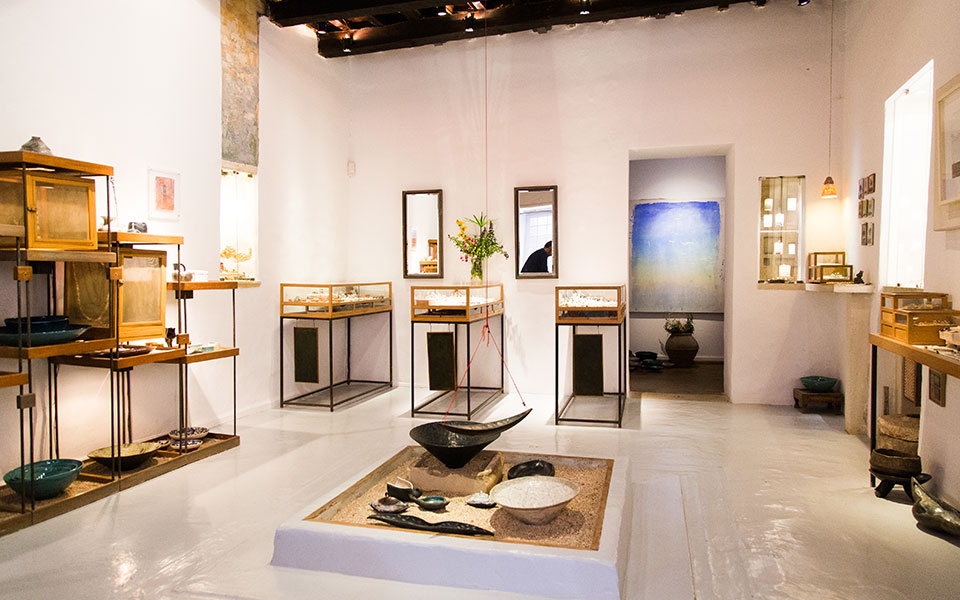Graced with one of the finest and best-preserved “Old Towns” in Greece, Hania is by far the prettiest and most captivating of Crete’s cities. Many even believe it to be one of the most beautiful in the Mediterranean, calling it the “Venice of the East.”
Evidence of its long-standing appeal is its millennia-spanning history of settlers and conquerors (Neolithic people, Minoans, Mycenaeans, Dorians, Romans, Andalusian Arabs, Byzantines, Venetians, Genoese, Egyptians and Ottomans), who selected it for its strategic position by the sea and its fertile lands, each leaving their indelible mark for all modern-day visitors and settlers to witness.
If you’re not sure about which way to go, here are three itineraries with distinctly different characters:

© Stelios Papardelas
Topanas District: WALK LIKE A VENETIAN
When setting out to explore the Old Town, try to resist the charming Venetian harbor, which will pull you towards it like a magnet; it’s best enjoyed as a dessert, preferably in the late afternoon when the scorching sun begins to set. Instead, surrender to the charms of the western, Venetian quarter of Topanas, with its meandering narrow alleys and archways which will shield you from the sun during the day and provide you with countless routes past picturesque façades and inviting entrances that, no matter how many times you stumble upon them, will always seem new. To paraphrase Heraclitus, you can never step on the same street twice.
Even though it may feel counterintuitive to use a map when the idea here is to surrender yourself to serendipity, do make a point of locating Angelou, Theofanous and Moschon streets to get a sense of how Hania looked like under Venetian rule, and Theotokopoulou Street to see the remains of the Venetian fortifications as well as a fine example of Ottoman architecture at No. 62. The rectangular stone building with the red shutters just across from it is the Venetian gunpowder magazine, after which the Ottomans chose to name the district: Tophane (which evolved into Topanas), meaning “armory” in Turkish.

© Maria Coveou
When the afternoon does arrive, make your way down to the Venetian harbor with its colorful, grand homes. To enjoy it in panoramic mode, take the long stroll past the 16th-century Venetian dockyards where the ships underwent maintenance over the winter, and all the way to the landmark lighthouse that looks like a minaret at the end of the breakwater.
Originally a 16th-century structure, it was rebuilt by the Egyptians in the 19th century, and adds to the charm of the harbor, especially at night when it is lit up. End your day on a sweet note at the charming little pastry shop Sketi Glika (18 Isodion, off the harbor) that is ready to seduce you with its colorful rustic décor and its delectable desserts.

© Stelios Papardelas

© Stelios Papardelas

© Stelios Papardelas
Splantzia District: ALLA TURKA
Should you decide to get away from the bustling crowds, head east to the more low-profile quarter of Splantzia, inhabited since Minoan times and the city center under Ottoman rule. The area was once synonymous with neglect, but in recent years many of its old houses have been renovated, and fresh new businesses have sprung up, transforming it into the most indie quarter of the Old Town.
Start your day here with a coffee under the old plane tree on Splantzia Square (aka 1821 Square), which witnessed brutal hangings during Ottoman rule but nowadays offers shade and an ideal setting for friendly encounters. Don’t head off without first taking a look at a most unusual church that is, in a sense, an emblem, accidental or not, of religious tolerance: the Church of Aghios Nikolaos, which once formed part of the 1320 Dominican monastery and which, since 1918, has featured both a Christian Orthodox bell tower and a Turkish minaret.
There’s plenty more to see as you stroll through the neighborhood’s inviting backstreets and, if you happen to be there on a Saturday, don’t miss out on the colorful farmers’ market on Minoos Street.

© Stelios Papardelas
In the afternoon, stop by Ride (52 Daskalogianni), the epitome of the neighborhood’s laid-back and alternative vibe, for a cup of coffee or a craft beer. Here you can also rent a bike and/or plan a bike tour with some helpful input. (You can get help with bike repairs here, too.)
From Ride, make your way to Kastelli Hill, where the center of the ancient city of Kydonia (on which modern-day Hania was built) was located. The area has some wonderful surprises, like the Venetian Rector’s Palazzo (17th century) at the end of Lithinon Street and a marvelous, panoramic view of the harbor from the “Balcony of Hania” at the end of Aghiou Markou Street. The balcony is, in fact, the enclosed courtyard of a neoclassical edifice that once housed the headquarters of the Great Powers (Britain, France, Austria-Hungary and Russia) at the end of the 19th century, and has been occupied since 2004 by a radical political group called Rosa Nera.
For dinner, head back down to Splantzia and pick a table in the atmospheric courtyard of “The Well of the Turk” (1-3 Kallinikou Sarpaki), which features an actual well and serves delectable Mediterranean and Turkish-Moroccan dishes. Bustling Hatzimichali Daliani Street, on the quarter’s southern border, will give you a taste of the local nightlife, and a chance for a nightcap.

© Stelios Papardelas

© Stelios Papardelas
Halepa District: NEOCLASSICAL FLAIR
Don’t leave Hania without first having ventured outside the eastern fortification wall towards the Halepa district which, from the mid-19th century, developed into an aristocratic suburb of European glamour, housing the consulates of the Great Powers, rich merchants and prominent citizens of Hania. Eleftherios Venizelos, the leader of the Cretan liberation movement and later prime minister, lived here. His house, built in 1880 and renovated in 1927, was turned in 2015 into an exemplary museum (venizelos-foundation.gr).
Royalty also resided in Halepa; the neoclassical palace of Prince George of Greece, built in 1882 and located next to Venizelos’ mansion, is still standing and can be admired from the outside. Prince George was also responsible for the quirky, Russian-style Church of Saint Mary Magdalene, which he commissioned in 1901 (it was completed in 1903), during his time as high commissioner of Crete, in honor of his sister Maria. It stands within a beautiful garden.

© Stelios Papardelas

© Asimina Mitrothanasi
farewell shopping
On 7 Angelou, Carmela’s pottery and jewelry is inspired by old motifs, often made using traditional techniques – they are veritable works of art.
At the gift shop Canea (45 Zampeliou), the Old Town’s most recognizable landmarks decorate a variety of mementos, from T-shirts to tote bags.
For the quintessential Cretan souvenir, head to Armenis (14 Sifaka), where Michalis makes traditional Cretan knives with mantinades (small poems) engraved on their blades.












